Until the beginning of the 19th century, ice cream was an exotic and rare dessert that was only available to the elite. However, by the mid-19th century, technology had evolved and ice cream was beginning to become more affordable to the general public. After the invention of the first ice cream maker, it took two other inventions to initiate mass production of ice cream.
In this detailed guide, we will take a deeper look at the ice cream makers used in the early years. By the time you reach the end of this article, you will understand the history of antique ice cream makers, how these ice cream makers work, and how to determine their value.
Table of Contents
The History of Antique Ice Cream Makers
1843: Nancy M. Johnson Patents an Ice Cream Freezer
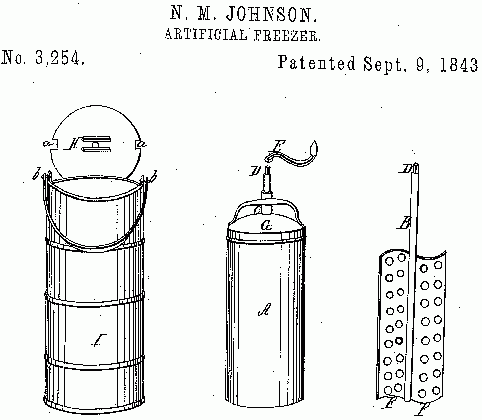
In 1843, a New York resident by the name of Nancy M. Johnson decided to obtain a patent for the original hand-cranked ice cream freezer. The ice cream maker featured a center paddle and had a crank that carried a handle.
To create an ice cream with the antique ice cream maker, one had to turn the crank for forty-five minutes. While 45 minutes may seem like a lot of time to spend on ice cream, Nancy M. Johnson’s antique ice cream maker used less labor compared to using a spoon for stirring.
The antique ice cream maker sold pretty quickly. Also, over 70 improvements were made to the machine in the years that followed. The improvements led to the creation of the antique White Mountain ice cream maker.
1843: Thomas Masters Creates His Ice Cream Apparatus
The same year as Nancy M. Johnson, a London resident by the name of Thomas Masters created the Ice Cream Apparatus. After applying patents for their inventions in the same year, the two innovators received their patents 2 months apart – Thomas Masters received his patent on July 6th, 1843 while Nancy M. Johson received hers on September 9th, 1843.
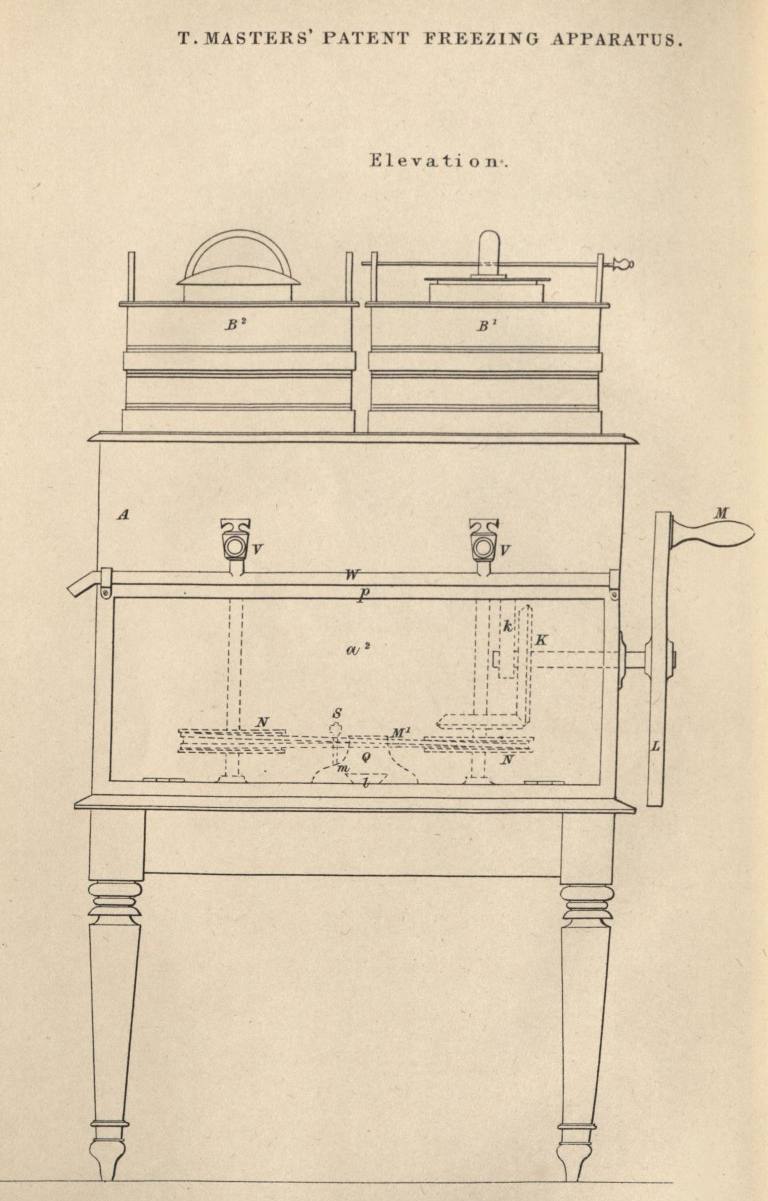
Thomas Masters’ Ice Cream Apparatus featured various interchangeable parts. The machine could be set up for private use, producing blocks of ice, ice cream, flavored ice, and cooling drinks and wine.
Thomas added special churns to the antique ice cream maker to ensure a proper beating-up process that was impossible to accomplish by hand. The churns created the smoothness and fineness necessary to ensure the ice cream and flavored ice did not separate.
The Ice Cream Apparatus had separate ice preserving containers for butter, fish, game, etc. Also, the apparatus had cold storage spaces for beer and wine.
1851: Jacob Fussell Turns Milk into Ice Cream
With excess milk, Jacob Fussell, a milk dealer who lived in Baltimore had to come up with a way to reduce wastage. The milk farmer decided to turn the milk into a product that wouldn’t go bad quickly. To Jacob, making ice cream with milk was a good idea.
Jacob Fussell is recognized as the creator of the first ice cream mass-production plant. The farmer turned the previously costly product into a more affordable treat.
Using the hand-cranked antique ice cream makers first made by Nancy M. Johnson, Jacob Fussell opened his ice cream shops and parlors in numerous locations, going as far as western Texas.
1866: Industrial Ice Harvesting
With the earliest antique ice cream makers demanding ice – and with this demand increasing after the establishment of large-scale ice cream making – ice cream harvesting became a thing.
Ice harvesting became industrial in the mid-19th century. Tons of ice were cut from the coldest regions in the world and shipped to regions that consumed the most ice. In 1866, for example, more than 25 million tons of ice were harvested in the United States alone.
The 1870s: German Engineer Carl von Linde Develops Industrial Refrigeration
The invention by Carl von Linde eliminated the need to cut and then store natural ice for use in the hand-cranked antique ice cream makers.
The 1880s: Small, Improved Ice Cream Makers for Domestic Use Find Their Way into the Market
These domestic antique ice cream makers feature a metal inner pail and a paddle that is then attached to the crank handle. The crank handle sits inside a bucket made of wood. The bucket carries a freezing mixture made of salt and ice.
To make ice cream with one of these antique ice cream makers, you will need to pour your ice cream mixture into their inner pial. Here, the ice cream mixture is churned and beaten as it freezes.
1926: Perfection of a Continuous-Process Freezer
The modern ice cream industry was born in 1926 when industrialists perfected a continuous-process freezer. This continuous-process freezer gave birth to modern ice cream makers which can mass-produce ice cream.
How Do Antique Ice Cream Makers Work?
Antique ice cream makers use one simple principle to make ice cream: the machines aerate the mixture as it freezes. Most of the antique ice cream makers will require you to follow the steps outlined below to make your ice cream:
Step 1: Create Your Ice Cream Mixture
Before you can use an antique ice cream maker, you will need to have your mixture ready. You can find an ice cream recipe that suits your taste and pre-cook it.
Step 2: Fill the Antique Ice Cream Maker’s Bucket with Ice and Rock Salt
Most antique ice cream makers will come with a wooden bucket surrounding a canister that sits in the center. Fill this bucket with rock salt and ice – these will keep the canister cold.
When filling the bucket, layer your salt and ice, going heavy on the salt between the layers. Be sure to fill the bucket to the rim. Next, top it off with salt to slow down the ice melting process.
When filling the bucket, keep the canister closed. This will keep your salt and ice from getting in the ice-making canister. Also, clear the canister’s opening before removing its lid to ensure none of the cooling materials go inside.
Important: Mixing ice with salt lowers the ice’s melting point. This means that even when the ice melts, its temperature will remain below the normal freezing point of 0 degrees Celsius (32 degrees Fahrenheit).
Step 3: Pour Your Ice Cream Mixture in the Canister
Pour your pre-cooked ice cream mixture into the metal canister. Do so carefully to ensure the salt does not get in the canister.
Step 4: Start Cranking the Antique Ice Cream Maker
After adding the ice cream mixture and closing the metal canister, the next step is cranking. The cranking will help aerate and smoothen the mixture. It will also eliminate the possibility of ingredient separation when you serve your ice cream.
Crank the handle around and around for approximately 30 to 45 minutes. If the ice melts during the cranking, you may need to add more. Having enough ice will ensure proper freezing.
Important: When using an antique ice cream maker, you may want to do the cranking outside. When the ice starts melting, it may leak out of the ice cream maker – this is especially the case if it is old and some of the wooden slats have come a little loose. When making the ice cream outside, you won’t have to worry about wetting your floor.
Step 5: Serve Your Ice Cream
After cranking the antique ice cream maker long enough, open the canister and serve your ice cream. You should serve the ice cream immediately.
You have to eat the ice cream fast because if you wait, it may turn into a puddle before your eyes – this tends to happen on hot summer days. If you cannot eat all the ice cream at once, transfer it to a container and put it in your freezer until you are ready to enjoy more homemade ice cream.
Types of Antique Ice Cream Makers
Hand-Cranked Ice Cream Makers
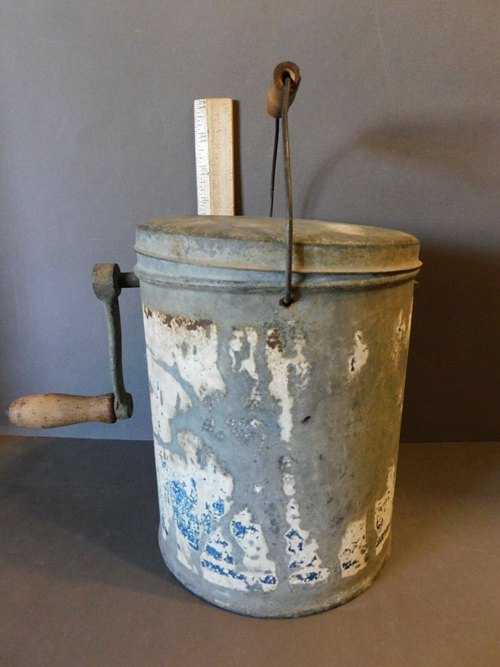
Perhaps the most popular type when it comes to antique ice cream makers, the first hand-cranked ice cream maker dates back to 1843. The instructions outlined above are for the original hand-cranked ice cream machine.
Made of a wooden bucket and featuring a metal canister in the middle, this type of ice cream maker uses ice and salt to freeze the ice cream mixture. To ensure mixing and smoothening during the freezing process, one has to manually crank the ice-cream maker. Most hand-cranked ice cream makers take 30 to 45 minutes to prepare ice cream.
Electric Counter-Top Antique Ice Cream Makers
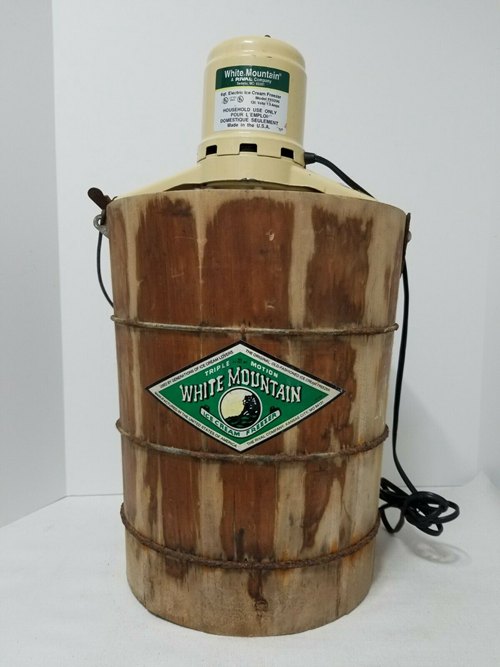
The first electric counter-top antique ice cream maker came to life in the 1920s. This type of ice cream maker utilizes a double-walled bowl with a solution between its walls – this is typically a mixture of urea and distilled water – that freezes below 0 degrees Celsius (32 degrees) Fahrenheit.
Once frozen, the bowl is put into the machine and the ice cream mixture is put in the bowl. Using electricity, the ice cream maker rotates paddles independently, stirring the ice cream mixture as the frozen bowl gradually freezes the ice cream.
Electric Freezer Unit Machines
This ice cream maker was produced for the first time in the 1920s after the invention of continuous freezing. The antique ice cream maker sits inside a freezer and operates the same way a food processor does.
Every few seconds, the machine uses its paddles to stir the ice cream mixture, keeping large ice crystals from forming in the ice cream. When the ice cream is sufficiently frozen, the machine’s paddles automatically lift and stop rotating. At this point, you can remove the ice cream maker from the freezer and serve your ice cream.
Electric Ice-Salt Coolant Machine
This type of antique ice cream maker was produced for the first time in the 1920s. The machine features an inner canister that holds the ice cream mixture and the assembly of scraper and churn.
A high-speed electric motor drives a mechanism that simultaneously rotates the metal canister, counter rotates the scraper and holds the churn paddles in place. The ice cream mixture is frozen by the ice-salt mixture outside and as the canister turns, the counter-rotating scraper removes the ice cream from the canister’s wall, returning it to the mixture.
Determining the Value of Antique Ice Cream Makers
Determining the exact value of an antique ice cream maker means more than just reviewing recent selling prices or locating the ice cream maker on an item price guide. There are several factors you need to consider when valuing antique ice cream makers.
The presence of the original marker’s marks, age, rarity, and item condition are some of the major factors you will need to consider. These factors will help you determine whether an antique ice cream maker is worth a lot or much less. Below, we will look into these factors in more detail:
1. Maker’s Marks
Ice cream makers stamped with the designer’s or manufacturer’s mark have a higher value than identical items with no signature. Antique White Mountain ice cream makers, for example, carry the company’s name. The manufacturer’s mark verifies that the antique ice cream maker is genuine and not a copy.
2. Condition
To determine the value of an antique ice cream maker, check it keenly to see if there is anything that could keep it from being considered “like new” or “in mint condition.” Flaws that often lower the value of antique ice cream makers include missing components, excessive wear, and cracks.
Always remember that while a minor nick may be negligible, a major crack on the bucket that holds your ice during cranking may be a deal-breaker.
3. Rarity
Antiques made in the early 1900s may be less valuable than those made in the 1850s. The reason for this is that the antiques from the 1850s are rarer than those made in the 20th century.
More 1900s antique ice cream makers in good condition are available than are well-maintained antiques from the 1850s.
4. Age
Old does not always mean valuable. The value of an ice cream maker lies in its demand.
A 150-year-old antique ice cream maker could be worthless if no one wants it. However, a 100-year-old ice cream maker could have a higher value if its demand is higher.
5. Authenticity
If an antique ice cream maker has been in your family for numerous generations and you understand its provenance, there is a very high chance that the antique is authentic.
An antique ice cream maker that was bought from a questionable flea market has to be authenticated before you can determine its value. Authentic antique ice cream makers will always have a higher value than unauthentic machines.
Antique Ice Cream Brands and Their Cost
Now that you know the factors that affect the cost of antique ice cream makers, we will look at different brands of antique ice cream makers and their costs:
Johnson Patent Ice-Cream Freezer
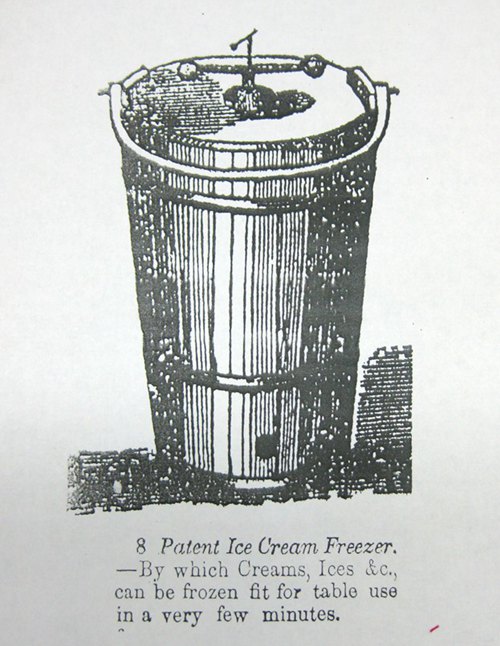
After patenting her ice cream model in 1843, Nancy M. Johnson’s design was not turned into a brand until 1848. It was in 1848 that William Young made the first ice cream maker and named it the “Johnson Patent Ice-Cream Freezer.”
However, as new companies started taking advantage of Nancy M. Johnson’s design, William Young’s machine did not stay in the market for long. We tried to find the price for this ice cream brand. Unfortunately, we could not find any historical records indicating the machine’s price.
White Mountain Antique Ice Cream Maker
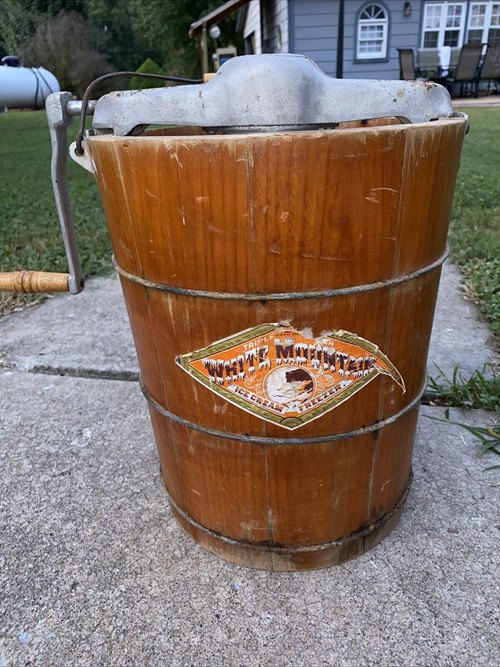
The White Mountain brand dates back to 1872 when Thomas Sands started the company in Laconia, New Hampshire. To produce its original antique ice cream makers, White Mountain made improvements to Nancy M. Johnson’s original design.
White Mountain antique ice cream makers currently available in the market date back to 1923. We analyzed several sellers online to determine the cost of these ice cream makers. The cheapest option had a price of $110 and the most expensive option would set a buyer back $499.95.
Acme Antique Ice Cream Makers
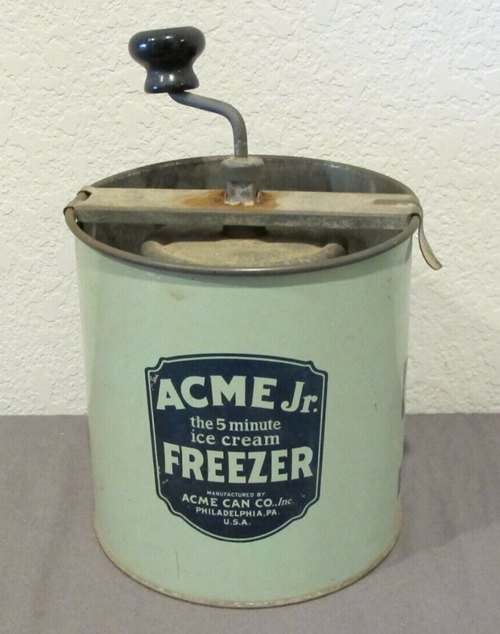
Acme was established for the first time in 1891. The company started making antique ice cream makers in the 1900s. Going by the name “Acme Ice Cream Freezers,” the brand featured a metal can surrounding the ice cream canister.
Online, we found antique Acme Ice Cream freezers dating back to 1910. The cheapest option had a cost of $30 while the most expensive had a price of $124.
Donvier’s Ice Cream Maker
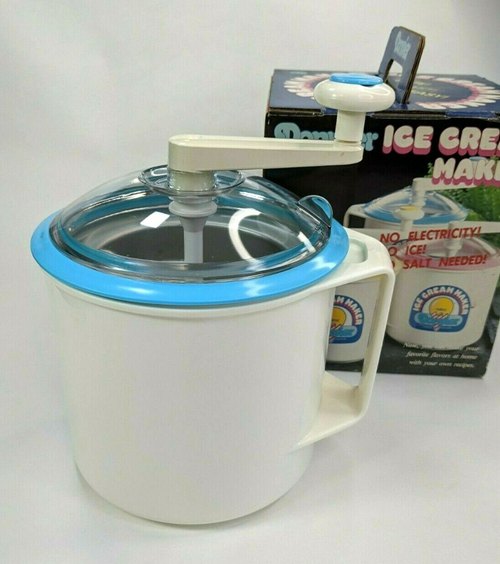
Donvier was a brand of Japanese-made antique ice cream makers. The brand started making its ice cream makers back in 1943.
Antique ice cream makers from Donvier are pretty small. They were designed to make very limited servings of ice cream. Online, the cost of vintage Donvier ice cream makers sits between $18 and $40.
Maid of Honor Antique Ice Cream Maker
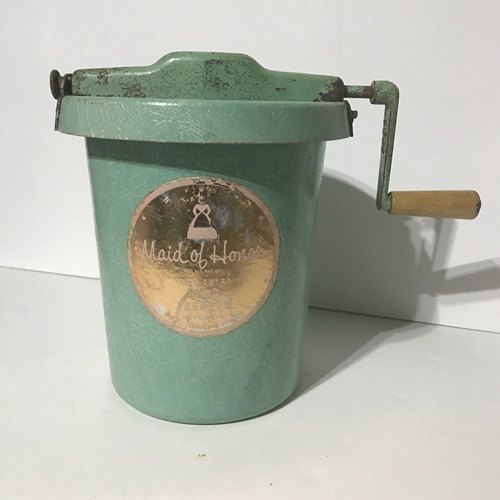
Sold and distributed by Sears & Roebuck company, the Maid of Honor Antique Ice Cream Maker dates back to the 1960s. This brand features both hand-cranked and electric antique ice cream makers.
Antique Maid of Honor pieces are available online for sale. The cheapest antique from the brand has a price of $50 while the most expensive will set you back $250.
Conclusion
The first antique ice cream maker is about 175 years old, having been produced in 1843. Using ice and rock salt, the ice cream maker cooled ice cream mixtures as someone manually cranked them to make the ice cream mixtures smooth and uniform.
This guide discusses the evolution of antique ice cream makers, from the ages of using natural ice to the 1920s when continuous freezing was first invented. We also show you how to use an antique ice cream maker. If you are on the market for an old-school ice cream maker, this guide offers you tips to help you determine the correct value of your preferred piece.
If you need more information about antique ice cream makers, be sure to let us know. Leave your question in the comment section. We will be more than happy to respond.
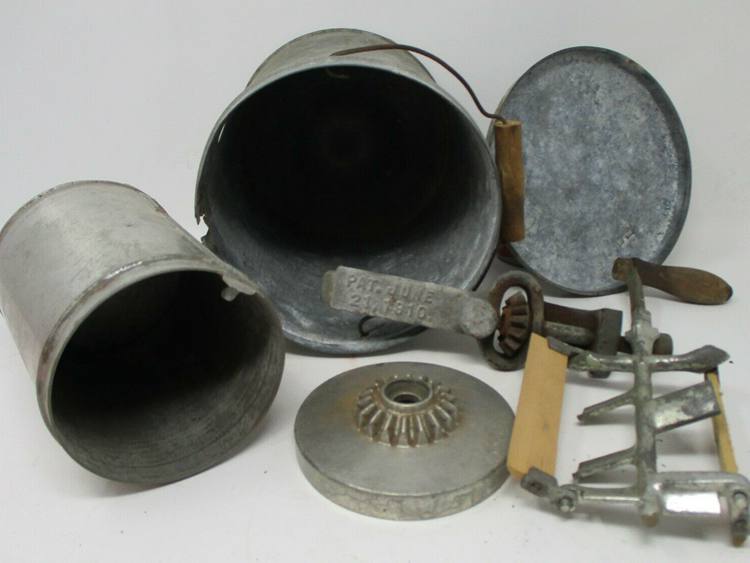






![Vintage Schwinn Bikes: [Types, Identification, and Values]](https://www.txantiquemall.com/wp-content/uploads/2022/05/5.-Schwinn-1967-Ramshorn-Fastback-Stingray-Sky-Blue-vtg-600x450.jpg)
